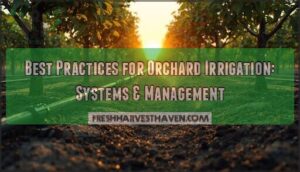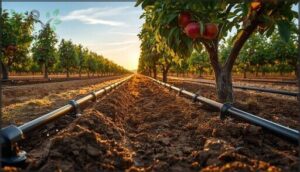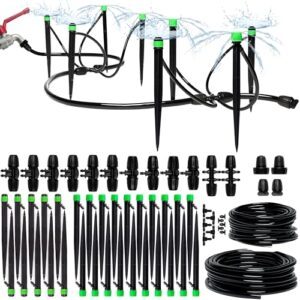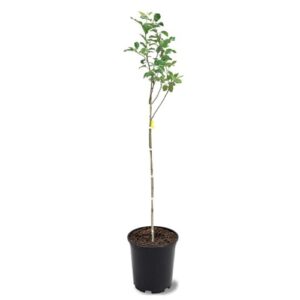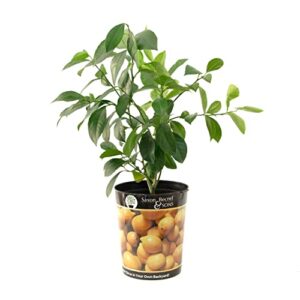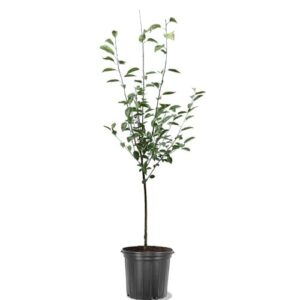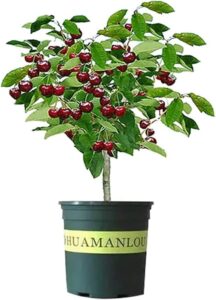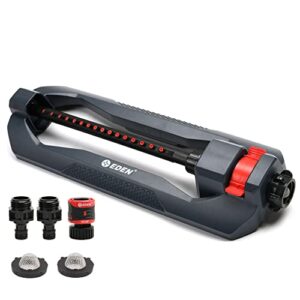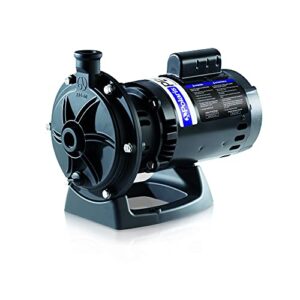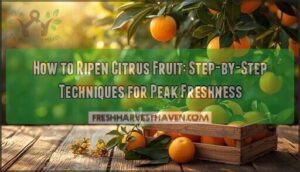This site is supported by our readers. We may earn a commission, at no cost to you, if you purchase through links.
Water your orchard wrong, and you’ll watch hundreds of hours and thousands of dollars wash away—literally. Too much water drowns roots and invites disease. Too little stresses trees and crushes yields. The margin between thriving and struggling often comes down to how you deliver water to the root zone.
Modern orchard irrigation isn’t about flooding rows on a schedule anymore. Best practices for orchard irrigation combine the right system design with responsive management—matching your soil, climate, and crop needs to efficient delivery methods like drip lines or micro-sprinklers.
When you understand what drives water demand and how to measure what’s actually happening in your soil, you gain control over one of the most critical variables in orchard profitability and tree health.
Table Of Contents
- Key Takeaways
- Key Factors in Orchard Irrigation System Selection
- Comparing Orchard Irrigation Methods
- Best Practices for Orchard Irrigation Management
- Determining Orchard Water Requirements
- Top 10 Products for Efficient Orchard Irrigation
- 1. Carpathen Adjustable Drip Irrigation System Kit
- 2. Red Delicious Apple Tree 1 Gal
- 3. Meyer Lemon Tree Live Citrus Plant
- 4. Bing Cherry Tree Sweet Harvest
- 5. Black Cherry Fruit Tree Live Seedling
- 6. Eden Essential Oscillating Lawn Sprinkler
- 7. Drip Irrigation System Kit With Timer
- 8. Eden Multi Adjustable Garden Sprinkler System
- 9. Polaris PB4-60 Booster Pump 60Hz
- 10. e.l.f. Flawless Satin Foundation Pearl
- Frequently Asked Questions (FAQs)
- Conclusion
Key Takeaways
- Choosing the right irrigation system depends on matching your soil type, water quality, topography, and crop rooting habits to efficient delivery methods like drip or micro-sprinklers, which can cut water use by 30-60% while boosting yields up to 40%.
- Effective irrigation management requires combining real-time soil moisture monitoring with weather-based evapotranspiration data to schedule watering precisely, potentially reducing water consumption by 20-50% compared to calendar-based approaches.
- Drip irrigation achieves 80-90% application efficiency—double that of surface methods—by delivering water directly to root zones, keeping foliage dry to reduce disease risk by up to 60% while supporting fertigation for 20-83% better nutrient uptake.
- Regular system maintenance including filter cleaning every 1-2 weeks, leak detection through flow monitors, and emitter inspection prevents the efficiency losses that plague over 80% of underperforming systems and protects your long-term investment.
Key Factors in Orchard Irrigation System Selection
Choosing the right irrigation system for your orchard isn’t a one-size-fits-all decision. Your soil, water source, terrain, and crops all play a role in determining what works best. Let’s walk through the key factors you’ll need to evaluate before making your choice.
Assessing Soil Type and Drainage
Soil texture determines how much water your orchard can hold and how quickly it drains. Think of it as the foundation of your irrigation decisions. Before you choose any system, assess these critical soil factors:
- Soil texture and water-holding capacity: Sandy loam soils at 0.9 m depth store roughly 3.6–4.5 inches of available water
- Infiltration rates: Coarse soils absorb water faster than clay, affecting application timing
- Rootzone aeration: Poorly drained soils restrict oxygen, stunting deep roots
- Soil compaction: Clay soils compact at bulk densities around 1.39–1.49 g/cm³, blocking root growth
- Field assessment: Percolation tests measure drainage speed—rates slower than 60 minutes per inch signal poor drainage
For orchards with suitable topography, consider surface irrigation methods as a cost-effective option.
Evaluating Water Availability and Quality
Your water source sustainability shapes every decision that follows. You need a reliable water supply that meets both quantity and quality demands.
Test your irrigation water for salinity—keeping electrical conductivity below 1.5 dS/m prevents salt stress in most fruit trees. Monitor sodium, chloride, and boron levels regularly, as concentrations above threshold values damage tree health and clog emitters, reducing system efficiency.
Knowing the source helps evaluate irrigation water quality.
Considering Orchard Topography
Topography shapes your orchard layout and water distribution more than most growers expect. Slopes exceeding 5% can increase runoff by 30–60%, slashing soil drainage and irrigation zones performance.
- Slope uniformity: Water distribution varies by up to 40% on sloped terrain, demanding pressure regulation and lateral placement perpendicular to slopes over 3%
- System adaptations: Drip irrigation saves 60% more water on hills than traditional methods
- Erosion management: Terracing and contoured layouts cut topsoil loss by 50% on steep ground
Matching System to Crop Type and Rooting Habits
Rooting habits determine how you’ll irrigate efficiently. Almonds need 4–5 feet of rooting depth, walnuts 4–6 feet, and pistachios over 6 feet—matching your irrigation system selection to these demands prevents waste.
Nearly 80% of mature tree roots sit in the top three feet of soil, so water demand matching matters. Drip systems target shallow root zones precisely, while deeper-rooted tree species benefit from less frequent, higher-volume applications that reach their entire root zone.
Factoring in Climate and Weather Patterns
Since climate conditions dictate water loss and crop demand, you need systems that adapt to weather patterns in real time. Rainfall variability and temperature impacts shape your irrigation strategy more than any other factor.
Consider these elements for climate resilience:
- Evapotranspiration rates fluctuate with temperature, sunshine, and wind
- Drought adaptation requires flexible scheduling and pulse irrigation
- Real-time weather data allows precise ET management
- Spring and autumn rainfall patterns affect bud burst and fruit expansion
- Every 1°F temperature shift alters yield considerably
Budget and Long-Term Maintenance Needs
Beyond setup costs, you’ll face recurring expenses that can make or break orchard profitability. Capital investment varies widely—drip systems run $500 to $3,000 per acre for surface setups, while micro-sprinklers average $2,100 per acre with 32-year system lifespan expectations.
Operating expenses, regular maintenance, and upgrade scheduling demand disciplined budget planning. Annual repair costs range from $40 to $100 per acre for drip systems, plus 10 to 20 labor hours per season for troubleshooting and irrigation system maintenance.
Smart budget planning allocates 10–20% of the initial investment to yearly upkeep. Here’s how costs break down:
| Cost Category | Annual Range | Replacement Cycle |
|---|---|---|
| Drip maintenance | $40–$100/acre | 7–10 years laterals |
| Labor hours | 10–20 hrs/acre | Seasonal operations |
| Water expenses | $84+/acre | Ongoing |
| Pump/pipeline | Major refurb cost | 20–32 years |
Proper maintenance schedules preserve component lifespans and minimize failures.
Comparing Orchard Irrigation Methods
Choosing the right irrigation method can make or break your orchard’s productivity and water efficiency. Each system has strengths and weaknesses that depend on your specific conditions, from soil type to budget constraints.
Let’s compare the main irrigation methods so you can decide which one fits your orchard best.
Drip Irrigation: Efficiency and Advantages
Drip irrigation delivers water straight to your tree roots, achieving 80–90% application efficiency—double that of surface methods. You’ll cut water use by 30–60% while boosting yields by 20–40%, thanks to consistent moisture that improves fruit size and sugar content.
Drip irrigation doubles efficiency and cuts water use by half while boosting orchard yields up to 40%
Disease control improves dramatically since foliage stays dry.
Add fertigation benefits and a payback period of just 1–3 years, and your ROI analysis becomes compelling.
Overhead Sprinklers: Pros and Cons
Overhead sprinkler irrigation cools canopies during heat waves, lowering air temperatures by 18–21°F and doubling avocado yields when temps hit 110°F+.
However, you’ll face tradeoffs: 25–50% more water waste, 35% higher disease risk from wet foliage, and 40% increased weed growth.
Cost analysis shows lower maintenance than drip systems, but yield impact depends on balancing climate benefits against fungal threats.
Micro-Sprinklers for Young and Sensitive Trees
Microsprinkler irrigation is ideal for young trees, providing gentle water distribution without causing root zone stress. This system offers significant advantages, including 20–30% water savings compared to surface methods and reduced disease risk due to minimal foliage wetting.
Here’s what makes this system effective:
- Tree health: Uniform root development across sensitive varieties
- Water distribution: 134 heads per acre at 0.43 GPM each
- Frost protection: Maintains above-freezing temps at 0.09 inches/hour
- Disease reduction: Less foliar contact lowers fungal outbreaks
- Cost analysis: $880–$2,000 per acre installation, break-even in seven years
Surface Irrigation: Limitations in Modern Orchards
Surface irrigation might seem simple, but it struggles in modern orchards. Water inefficiency rates often fall below 50%, with deep percolation and runoff wasting 30–40% of applied water.
Soil salinity spikes to 3.4 mS/cm in poorly drained areas, while land grading demands precision within 2–3 centimeters over 100 meters.
Modern layouts with high-density spacing expose uneven wetting patterns, and operational drawbacks like waterlogging increase disease risk by 60%.
Selecting Pipes, Emitters, and Filters for Your System
Once you’ve ruled out older methods, choosing the right hardware locks in your system’s long-term performance. Pipe pressure ratings matter—PVC class 160 withstands 160 psi, covering most orchard drip and sprinkler demands. Emitter discharge rates around 2 L/h at 100 kPa suit permanent crops, while a 200-mesh filter (74 micrometres) blocks particulates in clean groundwater. Component maintenance and clogging control through chlorination keep driplines flowing uniformly season after season.
- Match PVC pipe class to your maximum operating pressure plus surge capacity
- Select emitters with discharge exponents ≤0.5 to limit pressure-variation sensitivity
- Install 200-mesh screen filters for groundwater, media filters for surface sources
- Use chlorination or acid injections to prevent biological and mineral buildup
- Inspect gaskets, seals, and pressure regulators annually to maintain uniformity
Best Practices for Orchard Irrigation Management
Getting your irrigation system installed is only half the battle—the real work lies in managing it effectively over time. Smart management practices can make the difference between wasted water and a thriving, productive orchard.
In the sections that follow, you’ll find six essential practices that help you boost efficiency, protect tree health, and keep your system running smoothly year after year.
Scheduling Watering Based on Soil Moisture and Weather
To nail your irrigation schedule, you’ll need to combine soil moisture monitoring with weather data integration. Soil moisture sensors track real-time water levels in your root zone, while evapotranspiration rates tell you how much water your trees are actually using.
This precision irrigation approach can slash water use by 20-50% compared to guesswork methods, all while keeping your orchard thriving.
Integrating Fertigation for Nutrient Efficiency
Once you’ve dialed in your irrigation schedule, it’s time to deliver nutrients through the same system. Fertigation combines water and fertilizer delivery through your irrigation systems, syncing nutrient uptake timing with your trees’ natural demand cycles.
You’ll boost fertilizer use efficiency by 20-83% while cutting leaching environmental impact by up to 53%. The economic yield benefits are real—orchards report yield jumps of 29-64% with proper system optimization monitoring.
Monitoring Tree Health and Adjusting Watering
Feeding nutrients through your lines is just the start—watching your trees tell you what they actually need closes the loop. You can’t manage what you don’t measure, so tracking tree stress indicators and soil moisture levels guides every watering schedule adjustment.
Here’s what to monitor for adaptive management:
- Leaf color and wilting patterns signal early water stress before yield drops
- Stem water potential below -1.2 MPa means your trees need immediate irrigation
- Soil moisture sensors at 20 cm and 80 cm depths show root zone water status
- Canopy temperature 5°C above ambient flags deficit conditions fast
- Trunk diameter shrinkage exceeding 40 microns indicates physiological stress affecting plant growth
Remote sensing technologies like drone imaging detect stress zones weeks before visible symptoms appear, letting you adjust tree vigor management proactively. When sensors show volumetric water content dropping below 25%, it’s time to irrigate. This precision approach cuts water use by 52% while boosting yields 21% compared to guesswork scheduling.
Preventing Leaks, Clogs, and Water Waste
Beyond monitoring performance, you need to actively hunt down inefficiencies that drain your budget. A single faulty gasket can waste thousands of gallons per season, while clogged emitters sabotage distribution uniformity.
Here’s your maintenance checklist for leak detection, clog prevention, and water reduction:
| Issue | Prevention Action |
|---|---|
| Leaks | Install real-time flow monitors with automatic shutoff valves |
| Clogged emitters | Backwash filters weekly; treat bacterial buildup chemically |
| Pressure drops | Mount gauges at critical points; inspect gaskets monthly |
| Debris accumulation | Flush main lines after every cycle; clean sand filters |
| Over-irrigation | Use soil moisture sensors with switching tensiometers |
Technology adoption transforms system longevity—over 80% of underperforming systems improve dramatically through targeted irrigation system maintenance addressing leaks, clogs, and water wastage.
Using Mulch to Retain Soil Moisture
Mulching transforms soil moisture management by cutting evaporation rates up to 35%, which directly boosts irrigation efficiency. You’ll want organic materials like shredded bark or straw applied 2–4 inches thick at rates of 6–10 Mg ha⁻¹.
This practice elevates water-use efficiency by 27–33% while increasing yields 20–35%. Maintenance needs are minimal since bark and straw decompose slowly, requiring only periodic reapplication.
Adopting Smart Irrigation Technologies
Smart irrigation technologies transform water management by combining sensor integration with automated scheduling based on real-time weather data. These automated systems deliver measurable economic benefits while slashing labor demands.
- Soil moisture sensors improve irrigation efficiency by reducing water use 20–40% through targeted root zone delivery.
- Remote monitoring allows you to adjust schedules from anywhere, cutting manual field visits.
- Data analytics boost yields 10–25% by matching water application to actual tree needs.
Determining Orchard Water Requirements
Understanding how much water your orchard needs is the foundation of efficient irrigation management. Water requirements shift based on tree age, species, growth phase, and environmental conditions throughout the season.
By accurately calculating these needs and monitoring key indicators, you can improve water use while supporting healthy, productive trees.
Calculating Water Needs by Tree Age and Type
Your young trees won’t drink like mature trees—first-year trees use just 40% of mature tree ET, ramping up to 90% by year four.
Species water demand varies too: apples need a water factor of 0.8, while citrus craves 20% more.
Calculate tree water needs using ETc = ETo × Kc, adjusting Kc values by age and type for age-based irrigation precision.
Factoring in Growth Stage and Seasonality
Your trees’ water needs shift dramatically through the seasons. During flowering and fruit set, apples demand 120 mm of water, but fruit enlargement irrigation peaks at 319 mm—almost triple.
Regulated deficit irrigation lets you cut back strategically: stone fruits tolerate postharvest water stress, while citrus suffers if stressed early.
Adjust your watering schedule to match growth stage and seasonal changes, protecting critical phases while conserving water.
Monitoring Soil Moisture and Evapotranspiration Rates
Real-time data turns guesswork into precision. Install soil moisture sensors at one, two, and three-foot depths to capture your root zone, then pair readings with evapotranspiration rates calculated from local weather conditions. This combination reveals exactly when your trees need water.
- Capacitance sensors deliver volumetric water content accuracy within 2–3 percentage points when calibrated properly
- IoT soil moisture monitoring systems achieve 96.5% prediction accuracy using regression-based calibration
- FAO-56 Penman–Monteith equation integrates radiation, temperature, humidity, and wind for reliable ET calculation methods
- Remote sensing data like NDVI correlates with crop coefficients, mapping water stress detection across your orchard
- Precision irrigation scheduling tools logging every 10 minutes catch rapid soil moisture changes before trees suffer
Soil water potential near −80 kPa signals stress onset in apples—your cue to adjust the irrigation schedule. Combining soil moisture monitoring with ET-based scheduling cuts applied water while maintaining yields, because you’re responding to actual demand rather than calendar dates.
Tracking Irrigation and Rainfall With a Water Log
Your sensors only tell half the story—written records complete the picture. Keep a water log documenting every irrigation event and rainfall amount alongside soil moisture readings and weather conditions.
This data-driven scheduling approach furthers regulatory compliance while revealing patterns that refine your irrigation schedule.
Technology integration with automated controllers facilitates anomaly detection, flagging leaks or failures before they compromise water use efficiency or irrigation management across your entire operation.
Top 10 Products for Efficient Orchard Irrigation
You’ve got your system selected and your watering plan dialed in, but the right equipment can make or break your orchard’s efficiency.
The products below range from precision drip kits to booster pumps that keep water moving where it needs to go.
Each one resolves a specific challenge growers face when managing irrigation across different tree types and terrain.
1. Carpathen Adjustable Drip Irrigation System Kit
You need a drip irrigation system that delivers precision without the headaches of complex setup. The Carpathen Adjustable Drip Irrigation System Kit offers 30 emitters and over 60 pieces designed for efficient water usage right at the root zone.
Kit configuration includes UV-resistant tubing and adjustable emitters that deliver up to 60 gallons per hour per emitter. System installation takes less time than traditional sprinklers, and irrigation system components connect easily to standard water sources.
System maintenance stays simple with detachable, cleanable heads. User benefits include reduced water bills and healthier orchards through targeted irrigation.
Best For: Homeowners and small-scale orchard growers who want to save water and time while keeping plants consistently hydrated without the complexity of traditional sprinkler systems.
- Cuts water usage by 30–52% compared to conventional irrigation by delivering moisture directly to roots, which also reduces your water bill over time.
- Simple setup with push-to-connect fittings and expandable design—most users finish installation in under 2 hours per section.
- Durable, UV-resistant components with detachable emitter heads that are easy to clean, so you get reliable performance year-round with minimal maintenance.
- Some connectors can be hit-or-miss in quality, so you might need to swap out a few pieces during setup.
- Larger orchards or garden areas may need extra tubing and emitters beyond what’s included in one kit.
- Water pressure drops if you add too many emitters or use undersized pipes, so planning your layout carefully is key.
2. Red Delicious Apple Tree 1 Gal
After setting up your drip irrigation system, you’ll want trees that thrive under efficient water usage. The Red Delicious Apple Tree in a 1-gallon container responds well to precise watering frequency—mature specimens need 15-25 gallons weekly during the growing season.
This variety requires 900 chill hours and reaches fruiting by year two or three. Disease resistance to apple scab and powdery mildew makes it forgiving under drip irrigation, which keeps foliage dry.
Rootstock influence affects water dependency, but proper orchard irrigation systems deliver consistent fruit yield without waste.
Best For: Home orchardists in USDA zones 4-8 who want a reliable, disease-resistant apple tree that pairs well with drip irrigation systems and produces sweet, crisp fruit for fresh eating and cooking.
- Blooms late in spring to dodge frost damage, and shows solid resistance to apple scab and powdery mildew with minimal spraying needed.
- Starts producing fruit by year 2-3 and thrives under drip irrigation, needing just 5-10 gallons every 1-2 weeks once established.
- Large, dark red apples work great for fresh snacking, salads, pies, and applesauce, giving you plenty of kitchen options.
- Can’t ship to CA, AZ, AK, or HI due to state agricultural restrictions, limiting where you can order it.
- Needs a pollinator like Golden Delicious nearby to set fruit, so you’ll have to plant at least two trees.
- Vulnerable to fire blight and deer damage, so you’ll need to protect it with fencing and watch for bacterial infections.
3. Meyer Lemon Tree Live Citrus Plant
While apples suit colder climates, Meyer lemon trees thrive in zones 8-11 and demand citrus-specific irrigation practices.
Your mature tree needs up to 135 gallons daily in summer—20% more than standard fruit trees—delivered through drip irrigation when the top 2-3 inches of soil dry out. Watering frequency generally runs every one to two weeks, adjusted for rainfall.
Maintain soil pH between 5.5 and 6.5, provide 8-12 hours of sunlight, and watch for spider mites indoors.
This 1-gallon starter produces fruit within the first year with proper water requirements and pest resistance advantages.
Best For: Home gardeners in warm climates (zones 8-11) who want a low-maintenance citrus tree that produces sweet fruit year-round and can grow indoors or outdoors.
- Produces fruit within the first year and offers multiple harvests annually, giving you fresh lemons faster than most citrus varieties.
- Self-pollinating and disease resistant, so you won’t need a second tree or worry much about pesticides.
- Adapts to indoor or outdoor growing, making it flexible for apartments, patios, or gardens.
- Can’t be shipped to major citrus-growing states (FL, AZ, CA, TX, LA) due to agricultural restrictions.
- Needs significantly more water than other fruit trees—up to 135 gallons daily in summer for mature trees—requiring careful irrigation management.
- Susceptible to spider mites when grown indoors, so you’ll need to monitor and treat pests regularly in container settings.
4. Bing Cherry Tree Sweet Harvest
With heart-shaped Bing cherries ranking as the sweetest variety, you’ll manage 4-10 tons per acre when drip irrigation and fertigation needs align. Your tree requires 1,300 cubic meters per hectare annually—precision systems cut water use by 58% while boosting fruit tree health and productivity through uniform root health moisture.
Efficient irrigation practices matter most during mid-June harvest, when fruit won’t ripen off the branch. Watering fruit trees during critical growth periods and monitoring water quality improve yield, since this 20-30 ft. specimen produces 50+ pounds yearly under proper orchard water management and irrigation timing.
Best For: Home gardeners and orchard growers in zones 5-9 who want premium sweet cherries and can plant a second tree for pollination.
- Produces 50 pounds of incredibly sweet, heart-shaped fruit annually once mature, with commercial orchards achieving 4-10 tons per acre under optimal conditions.
- Drip irrigation systems cut water use by 58% while delivering consistent moisture to roots, making this tree surprisingly efficient for its 20-30 ft. size.
- Shows partial resistance to bacterial canker and other common cherry diseases, reducing the need for intensive chemical treatments in your orchard.
- Takes 4-7 years to reach significant fruit production, so you’ll need patience before enjoying substantial harvests.
- Requires another sweet cherry variety nearby for cross-pollination—it won’t produce fruit on its own.
- Can’t ship to California, Arizona, Hawaii, or Alaska due to agricultural restrictions, and may arrive with dry roots or leaf damage from transit.
5. Black Cherry Fruit Tree Live Seedling
For black cherry seedlings, seedling establishment requires intensive watering during the critical first months, achieving 2-4 inch growth rates within 30 days under proper irrigation systems. Once established, the tree’s water requirements decrease, though supplemental irrigation during dry spells maintains tree health and disease resistance.
Market value hits around $10 per bundle, but remember: these fruit trees take 7-10 years for production. Your orchard management strategy should include mulching and consistent moisture monitoring to support strong root development while avoiding waterlogged conditions that compromise growth.
Best For: Home gardeners and landowners willing to commit to long-term tree care who want a dual-purpose tree for both ornamental landscaping and eventual fruit production, and who have adequate space and patience for a 7-10 year timeline.
- Fast early growth potential with seedlings reaching 2-4 inches within the first month under good conditions, and can eventually become a productive fruit-bearing tree that also attracts wildlife
- Budget-friendly at around $10 per bundle, making it an affordable option for those looking to establish multiple trees or experiment with fruit tree growing
- Demonstrates partial disease resistance to common pathogens like bacterial canker, reducing the need for intensive disease management once the tree is established
- Extremely long wait time of 7-10 years before any fruit production begins, requiring significant patience and ongoing care with no immediate payoff
- Reports indicate inconsistent survival rates and variable seedling quality upon arrival, meaning you may need to purchase extras to account for losses
- Requires intensive watering and careful moisture management during the critical establishment phase, and cannot be shipped to California due to agricultural restrictions
6. Eden Essential Oscillating Lawn Sprinkler
The Eden 96213 Essential Oscillating Sprinkler covers up to 3,600 square feet through 16 precision nozzles, making it suitable for young orchard blocks or groundcover strips between tree rows. Achieve ideal water distribution by adjusting the sliding tabs to match your irrigation zones and orchard layout. At 40 psi, water flow rates remain consistent across the rectangular pattern.
For effective sprinkler irrigation, schedule watering during early morning hours to minimize evaporation.
Regular sprinkler maintenance—using the built-in cleaning pin and rinsing after use—preserves sprinkler efficiency and extends service life in agricultural applications.
Best For: Orchard growers and farmers who need adjustable rectangular coverage for young tree blocks, groundcover strips, or temporary irrigation during establishment phases.
- Covers up to 3,600 square feet with adjustable sliding tabs that let you target specific zones like tree rows or planting beds without wasting water on paths or borders.
- Built-in cleaning pin and stainless-steel filter washers make field maintenance quick and help prevent clogging from mineral deposits or debris in agricultural water sources.
- Weighted base and flexible construction reduce tipping during operation and resist breakage if accidentally stepped on in high-traffic orchard areas.
- Overhead spray pattern wets foliage, which can increase disease pressure in humid climates compared to drip or micro-sprinkler systems better suited for long-term fruit production.
- Maximum 3,600-square-foot coverage requires 40 psi water pressure, so actual irrigated area may be smaller on farms with lower residential well pressure or elevation loss.
- Lightweight plastic construction and Proposition 65 styrene warning suggest durability concerns for season-long commercial use compared to heavier metal sprinklers.
7. Drip Irrigation System Kit With Timer
Automating your orchard’s watering transforms daily irrigation into a precision operation. A drip irrigation system kit with timer delivers water directly to root zones at scheduled intervals, achieving 90-95% water efficiency—far surpassing sprinkler methods.
You’ll program the timer controller based on soil moisture monitoring data and seasonal needs, ensuring consistent water flow rates without manual intervention. Irrigation automation reduces labor while preventing over-watering that wastes resources.
Regular irrigation system maintenance, including filter checks and emitter inspections, keeps your drip system design performing reliably across growing seasons.
Best For: Orchard owners and gardeners who want to automate their watering schedule while maximizing water efficiency and reducing daily maintenance time.
- Achieves 90-95% water efficiency and can cut overall water use by up to 60% compared to manual watering, saving money on utility bills
- Programmable timer eliminates daily watering chores and delivers consistent moisture that can boost crop yields by 20-35%
- Easy setup takes under two hours for most installations, with durable components rated to last up to 20 years
- Instructions can be unclear, making initial setup confusing for first-time users
- Finding replacement parts like extra sprinkler heads or hose extensions is difficult without buying an entire new kit
- Some users report issues with proprietary connectors and Y-valve components that limit customization options
8. Eden Multi Adjustable Garden Sprinkler System
Flexible irrigation system layout separates productive orchards from struggling ones, and the Eden Multi Adjustable Garden Sprinkler System delivers that precision. You’ll configure irrigation zones across 840 square feet per unit at 50 PSI, with system modularity allowing expansion up to three connected sets.
Adjustable spray angles from 5° to 360° fine-tune water flow rates for varied tree spacing. Each sprinkler features on/off valves for targeted watering, while the tool-free assembly conforms to changing garden layout needs.
Sprinkler efficiency depends on maintaining adequate water pressure—monitor performance as you add extensions to preserve consistent coverage.
Best For: Orchard owners and gardeners who need a customizable irrigation system to water different zones with precise control over spray patterns and coverage areas.
- Highly adjustable spray angles (5° to 360°) and individual on/off valves let you target water exactly where your trees need it, reducing waste on paths or non-planted areas.
- Modular design with tool-free assembly makes it easy to expand coverage or reconfigure the layout as your orchard grows or changes.
- Covers up to 840 square feet per sprinkler at 50 PSI, with durable metal bases that stay anchored in varied terrain.
- Water pressure drops noticeably when you chain multiple units together, which can reduce coverage and spray consistency in later sprinklers.
- Hose quality concerns include reported leaks, meaning you might need to replace tubing sooner than expected.
- Limited to three connected sets per water circuit, which may require multiple separate systems for larger orchards.
9. Polaris PB4-60 Booster Pump 60Hz
Insufficient water pressure can choke your irrigation systems before they reach full efficiency. The Polaris PB4-60 Booster Pump delivers 0.75 horsepower at 3450 RPM, pushing pressure up to 35 psi to activate pressure-driven emitters and micro-sprinklers in your irrigation plan.
You’ll maintain consistent water flow rates across zones while operating at 6.4 amps on 230V for energy-conscious setups.
Pump maintenance includes periodic seal inspection, and you must run this non-self-priming unit alongside your main circulation pump to prevent dry-run damage and guarantee reliable booster systems performance.
Best For: Orchard operators and agricultural users who need reliable pressure boost for micro-sprinklers and drip irrigation systems running on dual-speed or variable-speed pumps.
- Delivers consistent 35 psi pressure at 3450 RPM to activate pressure-side emitters across multiple irrigation zones
- Energy-efficient operation at 6.4 amps on 230V works well with variable-speed systems for lower operating costs
- Stainless steel construction and easy seal replacement keep maintenance straightforward in outdoor agricultural settings
- Non-self-priming design requires installation below water level and constant operation with main circulation pump
- Average 2-3 year lifespan means you’ll likely face replacement costs sooner than other commercial-grade pumps
- Mixed customer reports on noise levels and durability raise concerns about long-term reliability in high-use applications
10. e.l.f. Flawless Satin Foundation Pearl
While irrigation systems and trees dominate orchard management, you shouldn’t overlook personal care during long field hours.
The e.l.f. Immaculate Satin Foundation in Pearl offers budget foundation coverage with vegan makeup credentials at $7.49 per 0.68 fluid ounce. Its glycerin-based formula provides skin hydration during sun exposure, and shade matching for fair, neutral undertones suits outdoor work conditions.
With 7-9 hour coverage longevity and an oil-free formulation, it meets practical needs when you’re monitoring water delivery or adjusting irrigation schedules across your orchard.
Best For: People with fair skin and neutral undertones who want affordable, buildable coverage that lasts through a full workday without breaking the bank.
- Costs just $7.49 and offers 7-9 hours of wear, making it one of the best values in budget foundations
- Vegan and cruelty-free formula with glycerin keeps skin hydrated instead of drying it out
- Buildable coverage means you can go light for everyday or layer it up when you need more
- Strong scent bothers some users and might be a dealbreaker if you’re sensitive to fragrance
- Can emphasize dry patches or texture if you skip primer, especially on less-than-perfect skin
- Discontinued by the manufacturer, so finding it in stores is getting harder
Frequently Asked Questions (FAQs)
How often should irrigation filters be cleaned?
You should clean your irrigation filters every 1-2 weeks during active growing seasons.
Systems using pond or reservoir water need more frequent cleaning due to organic matter buildup, while well water requires monitoring for iron bacteria.
Can recycled water be used for orchards?
You can conserve water, reduce environmental impact, and boost orchard sustainability by using recycled water for irrigation.
This approach meets water requirements safely when treated effluent follows proper irrigation safety standards, including filtration and monitoring protocols for water quality.
What causes uneven water distribution in orchards?
You’ll see uneven water distribution when hydraulic pressure fluctuations, soil variability, and irrigation design flaws combine. Topography effects and water quality issues worsen the problem. Pressure regulators help, but your irrigation system layout must match soil type perfectly.
How do you winterize an orchard irrigation system?
Before the first freeze, you must drain all water from pipes using compressed air blow-out methods.
Proper system drainage, pipe insulation, and component protection prevent costly bursts and maintain consistent water pressure throughout your irrigation system layout.
What certifications do irrigation installers need?
Anyone can dig a trench and lay pipe, but proper irrigation system installation demands professional licensing and industry standards.
You’ll need certifications like CIT or CID, with EPA recognition ensuring compliance with WaterSense program standards for orchards.
Conclusion
Precision pays in orchard water management. When you pair the right system with responsive monitoring, you’re not just watering trees—you’re protecting your investment and maximizing every gallon.
Best practices for orchard irrigation aren’t about following rigid schedules; they’re about reading your soil, understanding your trees, and adapting to conditions as they shift.
Master these fundamentals, and you’ll see the difference in root health, fruit quality, and long-term productivity.
- https://pubs.nmsu.edu/_circulars/CR542/index.html
- https://www.sciencedirect.com/science/article/abs/pii/S037837741300276X
- https://www.swansystems.com/wsu-apple-case-study/
- https://farmonaut.com/precision-farming/revolutionize-your-orchard-how-smart-irrigation-systems-and-precision-agriculture-boost-crop-yield-and-save-water
- https://apal.org.au/wp-content/uploads/2019/09/fo-ow-handout-09-sept-best-practice-water-mgmt-boland.pdf

